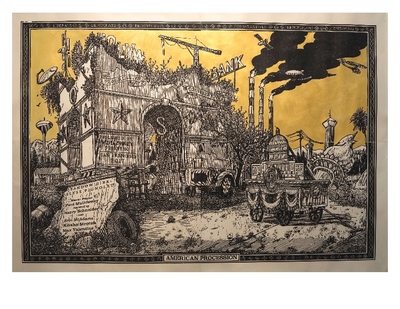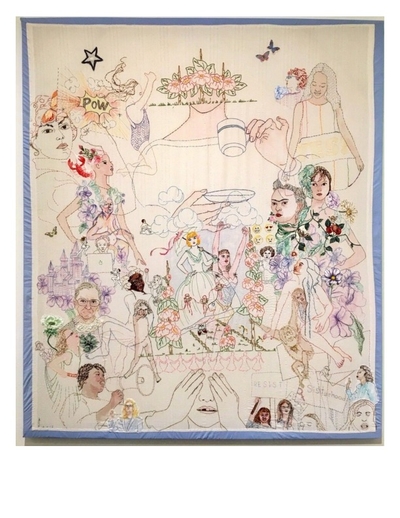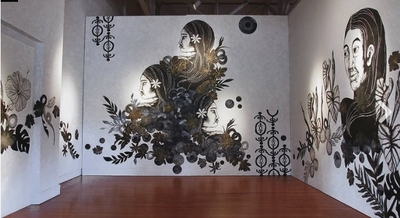Kanani Miyamoto's piece "Disrupting the Gaze" is one of the artworks featured at the Maui Arts& Cultural Center's SchaeferInternational Gallery. Courtesy Kanani Miyamoto
An artist with a message might want to encrypt it to keep it from the wrong hands. The five invited printmakers and a needle worker showcased in "Art & Activism: An Exhibition About Change" spell out their agendas boldly, demanding a world more righteous, sustainable and spiritual than the one we know.
The remarkable exhibition hangs at the Maui Arts & Cultural Center's Schaefer International Gallery through Oct. 31; it's a Maui exclusive. There's lots to think about and there's lots to see.
 For drums and trumpets, the prize-winner is the mammoth three-part "American Procession," by Sandow Birk and Elyse Pignolet from Los Angeles, printed from carved woodblocks in graphic black on gold.
For drums and trumpets, the prize-winner is the mammoth three-part "American Procession," by Sandow Birk and Elyse Pignolet from Los Angeles, printed from carved woodblocks in graphic black on gold.
The central panel, postcard- shaped, jumbles together battered symbols of lost national glory: a triumphal arch in ruins, smokestacks belching poison, Liberty's uplifted torch rolling in the dust. The Capitol appears as a prop for a carnival float, flat, with nothing behind it.
The panoramic side panels, more than five times as wide as they are tall, show generations of change agents on the march. From the left come generations of social progressives, Abraham Lincoln, Gertrude Stein and Martin Luther King Jr. prominent among them. From the right come armies of oppression, our 45th president crowing from a chair held high above the heads of his sympathizers, a Confederate flag waving before him. Slaves led in chains bring up the rear.
Partisan? Bet your bottom dollar it's partisan. For extra credit, take the time it takes — and it will take time — to study Birk's two king-size, single-panel allegories on American ideals as yet unkept. Here's political cartooning in the great tradition of Hogarth, Gillray, Nash and Goya. "In God We Trust."
Of Hawaiian ancestry, Kanani Miyamoto of Portland, Ore., calls out Paul Gauguin's "colonial gaze," sharing her outrage at an entry from his journal that reads, "All (the young women and girls) wish to be taken, literally, brutally taken, without a single word."
But suppose Gauguin is just the messenger here. As a lone alien with nothing much to his name but his paint box, what power could he wield over the practices of the natives? And haven't generations of art lovers, in Polynesia and around the world, seen in his island women celebrations of their inviolate mana?
No one has a stranglehold on truth; Miyamoto sees the history her way and chooses her battles accordingly. Gauguin turns up over and over in her prints as a vile little tick with a human head — no match for her stern, heroically scaled wahine with flowers in their hair.
 Mixed-media "tableaux" from Orly Cogan of New York examine evolving female types and stereotypes from the vantage point of a white, middle-age, middle-class feminist with the killer instincts of an X-rated, late-night stand-up comic. Cogan's vast cast of icons, mostly stitched by hand on old-time printed textiles, includes the "notorious" Ruth Bader Ginsburg, DC Comics' Wonder Woman, the smoldering Frida Kahlo and an anonymous young nude with chestnut hair now seen pushing a vacuum, now indulging in a Hostess CupCake.
Mixed-media "tableaux" from Orly Cogan of New York examine evolving female types and stereotypes from the vantage point of a white, middle-age, middle-class feminist with the killer instincts of an X-rated, late-night stand-up comic. Cogan's vast cast of icons, mostly stitched by hand on old-time printed textiles, includes the "notorious" Ruth Bader Ginsburg, DC Comics' Wonder Woman, the smoldering Frida Kahlo and an anonymous young nude with chestnut hair now seen pushing a vacuum, now indulging in a Hostess CupCake.
*
The two remaining installations speak more quietly. From the calls of local birds captured by the microphone and visualized on paper in black and white, Maui artist Abigail Romanchak has assembled a fresco documenting extinctions and progressive decline. The spectrograms resemble sheet music in notation we can't decipher for symphonies of nature we are on the verge of losing forever. Audio from the field, available on headphones, underscores the sense of tragedy.
Finally, beyond an entrance a child might walk through, though an adult must crawl, Paul Mullowney of San Francisco has papered an impromptu Zen chapel with his prints of calligraphic characters, Noh masks, and Buddhist saints praying in the lotus position, some of those saints reduced to skeletons under a sky that rains fire upon them.
Of the artist's messages, Mullowney's may be at once the most private and the most radical. Want to change the world? Start with yourself. Work from within.


